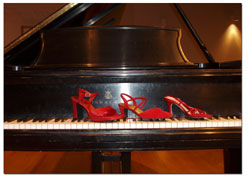| ||
Way beyond Brahms
by Judith Reynolds Like the sunny, windless weather we’ve been enjoying this fall, the chamber music season has slipped in unnoticed. And yet, the first two chamber concerts have been full of beauty and storm-tossed brilliance. Don’t let the charm of what’s known as musician’s music slip by. There’s more to chamber music than Brahms or the mini festival every summer under the umbrella of Music in the Mountains. For example, two weeks ago, pianists Scott Hagler and Linda Mack inaugurated the St. Mark’s Recital Series. Organized by Hagler, director of music at St. Mark’s, this is the second year for the series. Its purpose is to bring intimate, high-quality musical performance to people who want more than pop, folk, jazz or symphonic fare on their table. The Hagler-Mack all-keyboard concert brought together music for piano, organ and harpsichord. Some dazzling four-hands, one-piano pyrotechnics amazed the audience, but there were many quieter musical moments to relish as well. Last Sunday in Roshong Recital Hall on the Fort Lewis College campus, the “new” Red Shoe Piano Trio dipped its collective toe in the waters of Mozart, Debussy and Shostakovich. Since the departure of violinist Mikylah Myers McTeer from the Fort Lewis College Music Department, the faculty trio has had to regroup. Joining stalwarts Lisa Campi, piano, and Katherine Tischhauser, cello, violinist Kasia Sokol brings a certain fluidity, sure technique and a confident performance style. A native of Poland, Sokol came to the United States in 1994 to study at the Interlochen Arts Academy in Michigan. Since then, she completed a bachelor’s degree at Western Michigan University and a master’s from Northwestern. She’s now completing her doctorate at Indiana University. As a duo, Sokol and Campi began the program with two movements from Mozart’s Sonata for Violin and Piano in G major, Op. 301. Playful, often dance like, the work opened the evening with the sparkle of an 18th-century chandelier. The musicians were merely toying with the audience, however. The clarity of the Enlightenment soon gave way to the dark clouds of the 20th century. Campi and Tischhauser played a second work for a duo – Debussy’s Sonate pour violoncello et pian – not the mesmerizing Debussy of high Impressionism, all color, light and mutable tone. This was the Debussy of old age, illness and disillusionment, his music, like the century itself, breaking apart in shards of glass. Performed with fervor and intensity, the musicians gave us serious music for a serious time. After intermission when the full trio finally appeared together to play as the “new” Red Shoe Piano Trio, the mood darkened even more. The musicians delivered a powerful reading of the Shostakovich Trio No. 2, an intense, often grotesque work. With numerable quotations from Jewish folk tunes, the piece layered bittersweet melodies over martial rhythms to create a kind of savage dance macabre – especially in the final movement. Written in 1944, the work ostensibly protested Hitler’s persecution of the Jews; the Russian composer’s work may have also been a disguised cry against a tyrannical Stalinist regime. Credit the women of the Trio for bringing such a forceful, bittersweet piece of chamber music to our concert stage. Not only did Shostakovich break new ground in contemporary chamber music, our musicians from the ivory mesa gave us the full fury of his powerful statement. That’s how the chamber music season has begun, folks, and we have more interesting and unusual programs to look forward to. Among upcoming recitals, concerts and series to consider: • Fri., Nov. 9, begins the Unitarian Universalist Recital Series. Organized by pianist Marilyn Garst, the three-part series begins with a solo recital by Garst. It continues with a solo appearance by FLC percussionist John Pennington next Feb. 15. Among other works, Pennington will perform Emmanuel Sejourne’s Concerto for Vibraphone and Orchestra as well as works by Bach, Vivaldi, Ney Rosauro and Keith Jarett. The series concludes with a cello-piano duo featuring Garst and her sister, professional cellist Bonnie Mangold, on April 15. The program includes works by Beethoven, Faure, Hindemith and Piazzolla. Garst recently moved to Durango with her husband, Ron. She is the music director at the Unitarian Church and appeared as guest harpsichordist in last summer’s Music in the Mountains. Garst holds a doctorate from Michigan State University with additional study at Juilliard and the Aspen School of Music. For 25 years, she taught piano at The George Washington University and headed up harpsichord and keyboard ensemble studies. Her program on Nov. 9 will include works by Haydn, Schubert, Ginastera and one piece by the 20th-century American composer Emma Lou Diemer. • Fri., Jan. 18, mezzo-soprano Nan Wagner continues the St. Mark’s Recital Series with a program of classical works topped off by a selection from the Broadway musical “Wicked.” The series continues with soprano Gemma Kavanagh on March 14, and pianist Andrew Todd on April 25. • Sun., Jan. 20, The Adams Foundation Piano Recital Series begins the new year with Jeanne Stark-Lochmans, a Belgian pianist who now makes her home in San Francisco. This continues the recital program begun by the San Juan Symphony two years ago to bring top-quality soloists to the Four Corners for a more intimate chamber music experience. •
|


